Publications
Publications
Lessons Learned
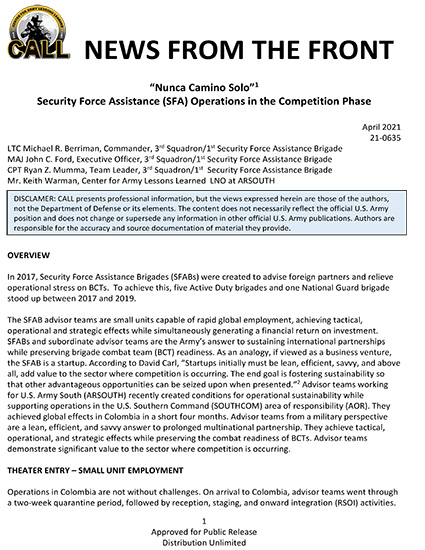 21-635 - "Nunca Camino Solo" Security Force Assistance (SFA) Operations in the Competition Phase
21-635 - "Nunca Camino Solo" Security Force Assistance (SFA) Operations in the Competition Phase
This article describes the successes of a Security Force Assistance Brigade's deployment to Colombia to advise and assist in counternarcotics efforts.
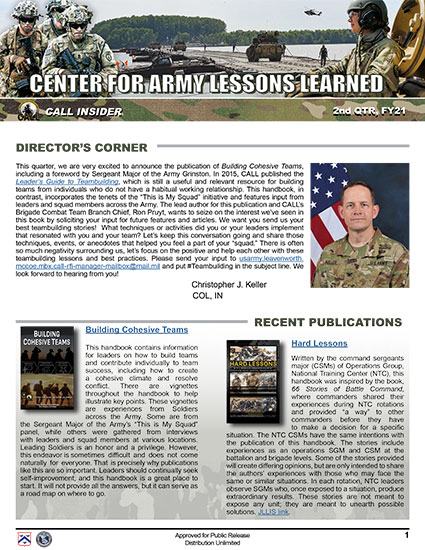 CALL Insider Newsletter 2nd QTR, FY21
CALL Insider Newsletter 2nd QTR, FY21
Catch up on what you may have missed and please share widely within your organizations.
- Building Cohesive Teams
- Hard Lessons
- Offensive and Defensive Operations Against a Near-Peer Threat
- Leader Development in Contact
- Latest Warfighter Training Support Packages and Training Circulars
- News from the Combat Training Centers And More!
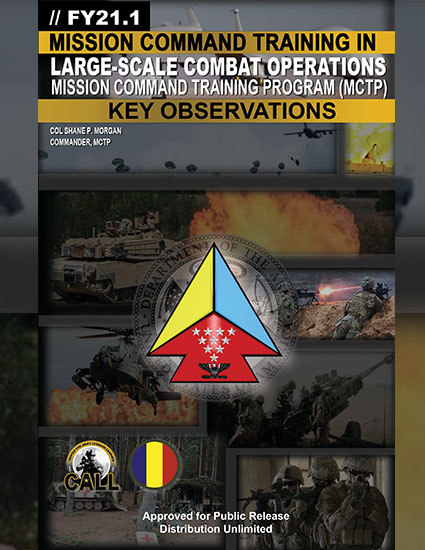 FY21.1 MCTP Key Observations Bulletin
FY21.1 MCTP Key Observations Bulletin
The information in this handbook is a snapshot of MCTP’s recent observations of Army training in a large-scale combat operations environment. These observations were written by a collaborative group of experienced officers, noncommissioned officers, and chief warrant officers working in conjunction with highly qualified expert-senior mentors. In an effort to increase the frequency of sharing observations, best practices, and trends, MCTP will continue publishing this handbook on a semi-annual basis and print cargo pocket-sized books for easier reference.
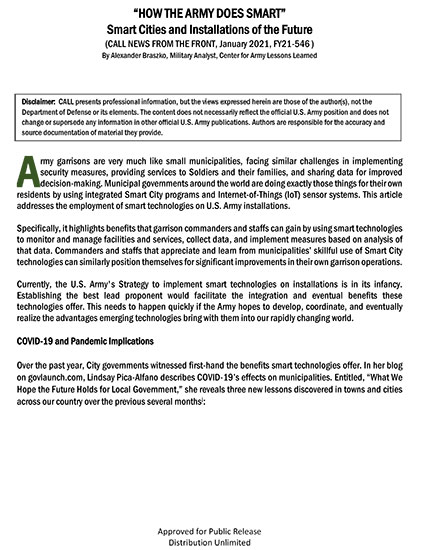 News From the Front - How the Army Does Smart
News From the Front - How the Army Does Smart
This article explains the municipal initiative or trend known as Smart Cities, which includes using "Internet of Things" networks, data collection by cutting edge technologies and sensors, and data-driven decision making. It also covers several years’ worth of Army experiments, proof of concepts, and modernization initiatives related to Smart Cities and Smart Technologies from an Army installation perspective. Finally, it coincides with the recently released Army Installations Strategy and identifies organizations leading installation of the future efforts.
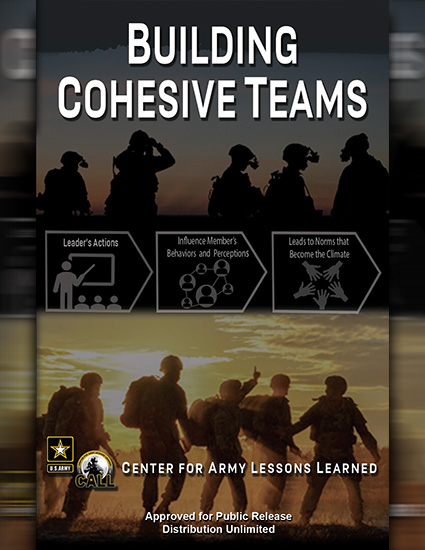 Building Cohesive Teams
Building Cohesive Teams
Cohesiveness is critical to high performing teams. Each member must understand their role in the team, know their responsibilities, and know that their teammates are also performing their duties. This handbook describes methods to build cohesive teams and provides indicators to measure performance. It incorporates the Army's "This is My Squad" initiative and is a good resource for leaders at all echelons.
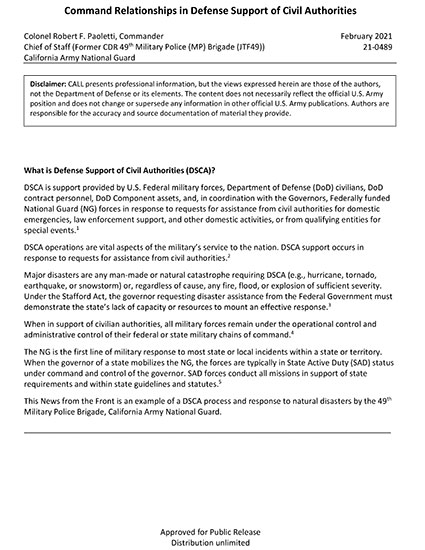 News From the Front: Command Relationships in Defense Support of Civil Authorities
News From the Front: Command Relationships in Defense Support of Civil Authorities
Defense Support of Civil Authorities (DSCA) is support provided by U.S. federal military forces, Department of Defense (DoD) civilians, DoD contract personnel, DoD component assets, and, in coordination with the governors, federally funded National Guard (NG) forces in response to requests for assistance from civil authorities for domestic emergencies, law enforcement support, and other domestic activities, or from qualifying entities for special events. Major disasters are any man-made or natural catastrophe requiring DSCA (e.g., hurricane, tornado, earthquake, or snowstorm) or, regardless of cause, any fire, flood, or explosion of sufficient severity. Under the Stafford Act, the governor requesting disaster assistance from the federal government must demonstrate the state’s lack of capacity or resources to mount an effective response. The NG is the first line of military response to most state or local incidents within a state or territory. This News from the Front article is an example of a DSCA process and response to natural disasters by the 49th Military Police Brigade, California Army National Guard.
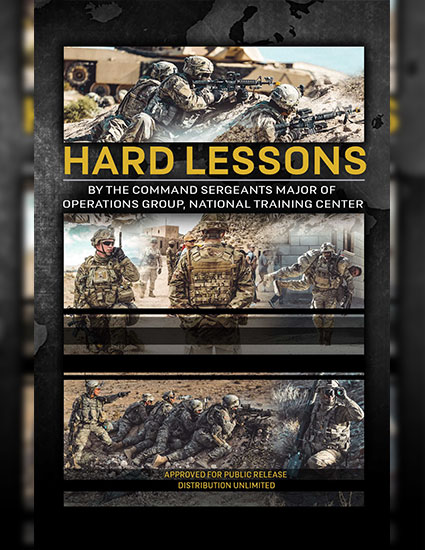 21-07 - Hard Lessons
21-07 - Hard Lessons
Written by the sergeants major (SGMs) of Operations Group, National Training Center (NTC), this handbook was inspired by the book, “66 Stories of Battle Command,” where commanders shared their experiences during NTC rotations and provided “a way” to other commanders before they have to make a decision for a specific situation. The NTC SGMs have the same intentions with the publication of this handbook. The stories include experiences as an operations SGM and command sergeants major (CSM) at the battalion and brigade levels. Some of the stories provided will create differing opinions, but are only intended to share the authors’ experiences with those that may face the same or similar situations. In each rotation, NTC leaders observe SGMs who, once exposed to a situation, produce extraordinary results. These stories are not meant to expose any unit; they are meant to unearth possible solutions.
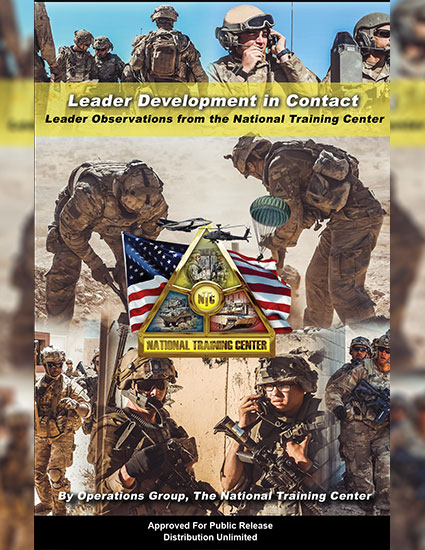 21-04 - Leader Development in Contact
21-04 - Leader Development in Contact
In this handbook, leaders from the National Training Center (NTC) Operations Group examine the art of leadership, its application on the replicated NTC battlefield, and what some of the more successful rotational unit leaders do to build winning teams. Each chapter, written by a senior observer controller/trainer, covers the tactics, techniques, and procedures that have been demonstrated to be successful in a specific warfighting function. Leader Development in Contact will be a valuable addition to every leader's 'professional development toolkit.
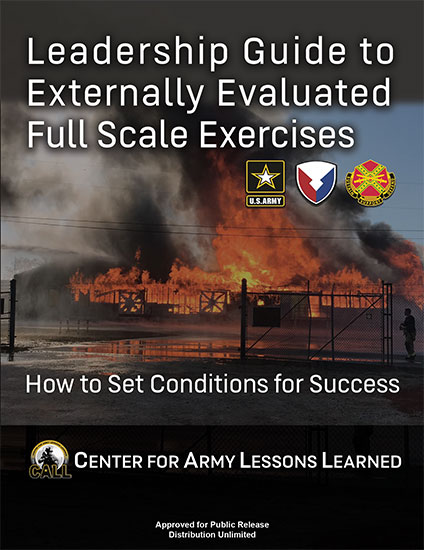 21-09 - Leadership Guide to Externally Evaluated Full Scale Exercises
21-09 - Leadership Guide to Externally Evaluated Full Scale Exercises
This handbook provides Senior Leaders and Garrison Commanders a guide to the Installation Management Command's (IMCOM) Full Scale Exercise (FSE) Program. It details the role of leaders in training, the design process, the external evaluation process, and Corrective Action Plan (CAP)/Improvement Plan (IP) process. The purpose of this handbook is to provide Installation leadership a timeline for engagement in the FSE process and strategies for planning, execution success, and improvement.
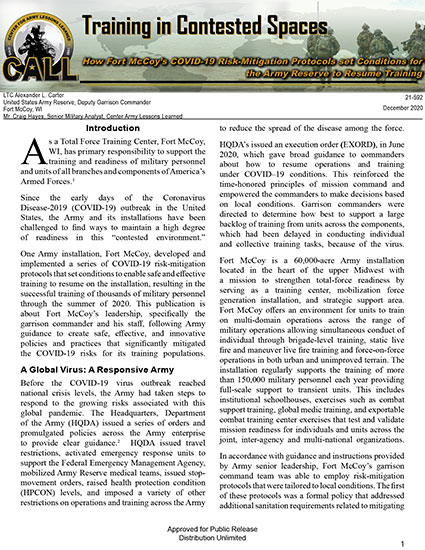 News From the Front: Training in Contested Spaces
News From the Front: Training in Contested Spaces
Fort McCoy developed and implemented a series of COVID-19 risk-mitigation protocols that set conditions to enable safe and effective training to resume on the installation, resulting in the successful training of thousands of military personnel through the summer of 2020. This publication is about Fort McCoy's leadership, specifically the garrison commander and his staff, following Army guidance to create safe, effective, and innovative policies and practices that significantly mitigated the COVID-19 risks for its training populations.
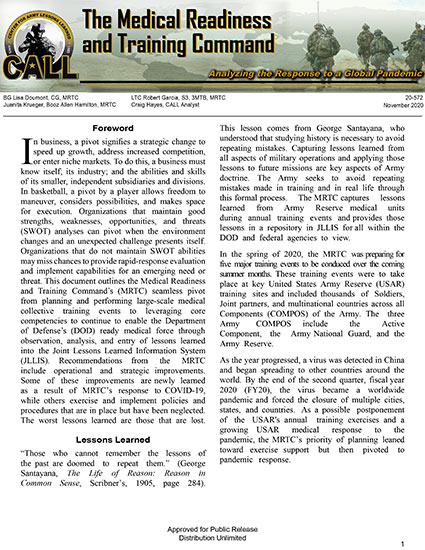 News From the Front: The Medical Readiness and Training Command: Analyzing the Response to a Global Pandemic
News From the Front: The Medical Readiness and Training Command: Analyzing the Response to a Global Pandemic
Organizations that maintain good strengths, weaknesses, opportunities, and threats analyses can pivot when the environment changes and an unexpected challenge presents itself. This document outlines the Medical Readiness and Training Command’s (MRTC) seamless pivot from planning and performing large-scale medical collective training events to leveraging core competencies to continue to enable the Department of Defense’s ready medical force through observation, analysis, and entry of lessons learned into the Joint Lessons Learned Information System. Recommendations from the MRTC include operational and strategic improvements. Some of these improvements are newly learned as a result of MRTC’s response to COVID-19, while others exercise and implement policies and procedures that are in place but have been neglected.
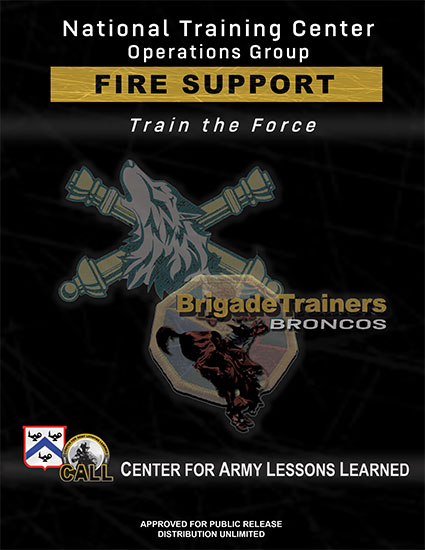 21-05 - NTC Fire Support Handbook
21-05 - NTC Fire Support Handbook
At the National Training Center, brigade combat teams (BCTs) have a difficult time establishing, maintaining, and transitioning a permissive fires environment at echelon within the decisive action training environment to shape the BCT deep fight and mass effects in the close fight in support of tactical and operational objectives. This handbook provides the fires community a way to plan, prepare, and execute its mission to establish, maintain, and transition a permissive fires environment at echelon to shape the battlefield. It also provides commanders and their staff with insights on the capabilities and employment of fires.
Pages
Handbooks
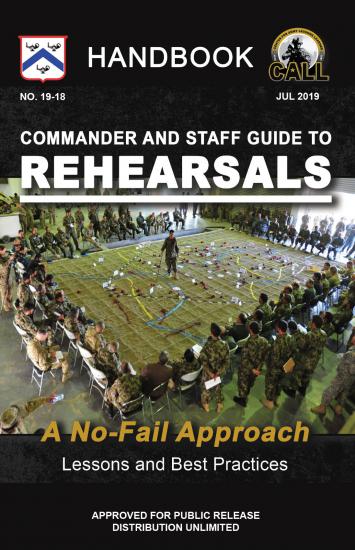 19-18: Commander and Staff Guide to Rehearsals A No-Fail Approach Handbook
19-18: Commander and Staff Guide to Rehearsals A No-Fail Approach Handbook
This handbook provides a cohesive instructional manual on rehearsals; it incorporates doctrine and best practices to mitigate unit challenges in executing rehearsals at all levels, while also acknowledging that the basic tenets of rehearsals have not changed. U.S. forces operate in a complex operating environment of cyber, multinational, and multi-domain players. This environment increases operational complexity, thus necessitating timely and effective rehearsals to optimize these capabilities and increase the likelihood of success.
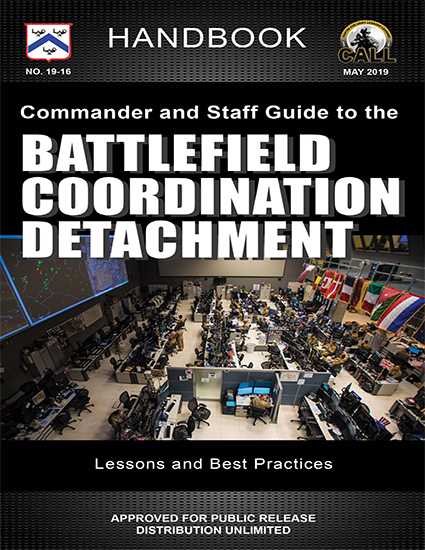 19-16 - Commander and Staff Guide to the Battlefield Coordination Detachment Handbook
19-16 - Commander and Staff Guide to the Battlefield Coordination Detachment Handbook
This handbook is designed to inform Army leaders of the BCD's functions, roles, and capabilities, along with best practices and lessons from numerous exercises, experiments, and named operations. These insights should prove invaluable to all Army leaders, newly assigned BCD personnel, and organizations that work with BCDs.
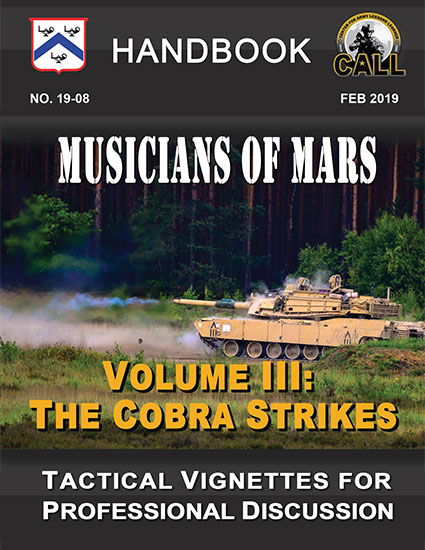 19-08 - Musicians of Mars III Handbook
19-08 - Musicians of Mars III Handbook
Musicians of Mars III “The Cobra Strikes” picks up the tale of LTC Milner and Task Force Mustang in the aftermath of their successful defense (in CALL Handbook 16-12, Musicians of Mars II) of engagement area Blackjack. The responses to that publication from our tactical audiences was that there was appetite for a follow-on publication that emphasized offensive operations. This volume delivers. As with Musicians of Mars II, this handbook takes the reader through a fictional scenario where the tactical leaders make decisions, some good and some not so good, that impact subsequent actions. Musicians of Mars III will have its leaders learning and improving as they progress through tactical engagements. This was intentional in the development of this publication, and is designed to facilitate tactical discussions at the company and platoon levels.
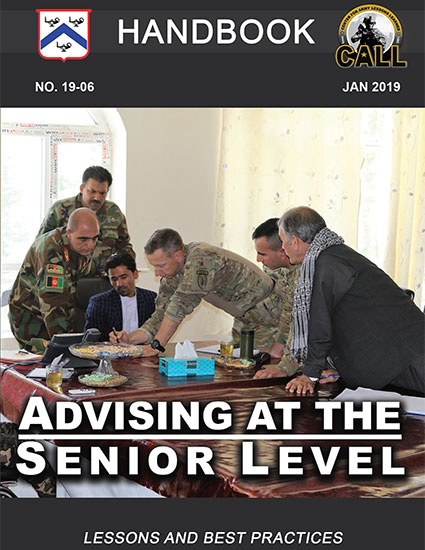 19-06 - Advising at the Senior Level Handbook
19-06 - Advising at the Senior Level Handbook
Advising at the Senior Level offers advisors at senior or ministerial levels a perspective on operating more efficiently with international governments, ministries of defense, embassies, and foreign security forces. It bridges gaps in expertise when advising at the ministerial level through insights and best practices -- highlighting what senior advisors do, how the operational environment differs, and describing how to integrate through the processes of the Department of Defense, Department of State, and the partner nation. Our purpose is to provide key insights and best practices for senior advisors in a convenient reference that enables their work at the ministry, department, and component levels. The insights in this handbook are applicable down to the tactical level and should be shared widely.
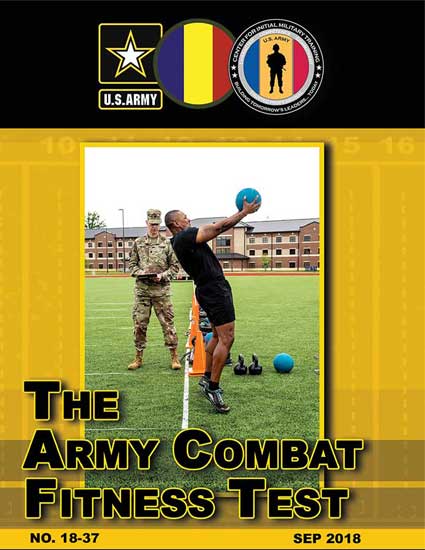 18-37: The Army Combat Fitness Test Handbook
18-37: The Army Combat Fitness Test Handbook
This handbook is a compilation of products developed by the Center for Initial Military Training (CIMT) in preparation for the Army-wide implementation of the ACFT. Refinements are expected as testing units provide feedback, but in the interim, this handbook provides commanders, leaders, and Soldiers with a guide to preparing for and administering the ACFT.
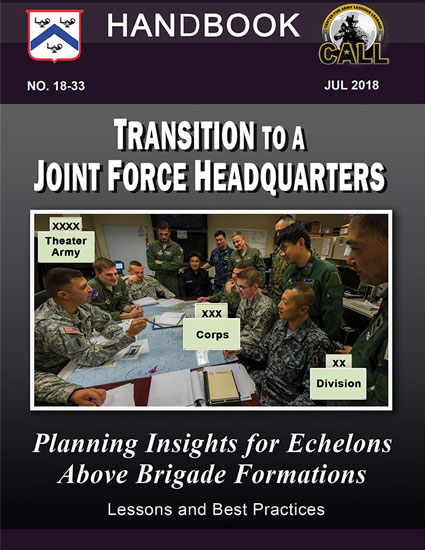 18-33 - Transition to a Joint Force Headquarters - Planning Insights for Echelons Above Brigade Handbook
18-33 - Transition to a Joint Force Headquarters - Planning Insights for Echelons Above Brigade Handbook
The Transition to a Joint Force Headquarters - Planning Insights for Echelons Above Brigade Handbook leverages Center for Army Lessons Learned collections in active joint operation areas and joint exercises to provide commanders and staffs at echelons above brigade a guide to transitioning to a joint force headquarters. Our purpose is to provide key insights, lessons, and best practices for commanders and staffs at echelons above brigade for forming and operating as a joint headquarters. The areas of emphasis in this handbook are: forming the joint headquarters; planning and operating in the joint/combined operating environment; building the command and control architecture; integrating force enablers; and, leveraging joint, interorganizational, and multinational processes.
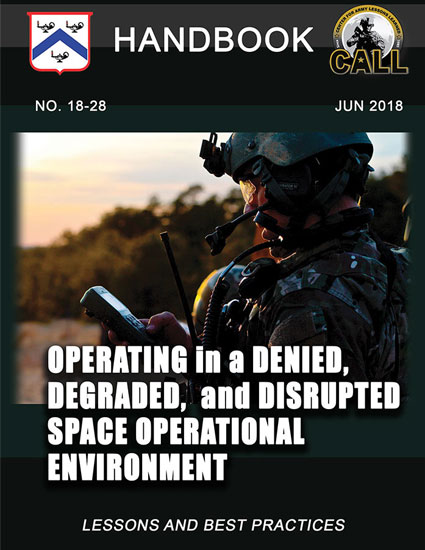 18-28: Operating in a Denied, Degraded, and Disrupted Space Operational Environment Handbook
18-28: Operating in a Denied, Degraded, and Disrupted Space Operational Environment Handbook
The space domain is a vital component of the emerging concept of multi-domain battle and the warfighter is reliant on the capabilities it provides to be successful in executing operations. This collaboratively produced handbook will give the warfighter techniques and strategies to successfully operate in a denied, degraded, and disrupted space operational environment (D3SOE).
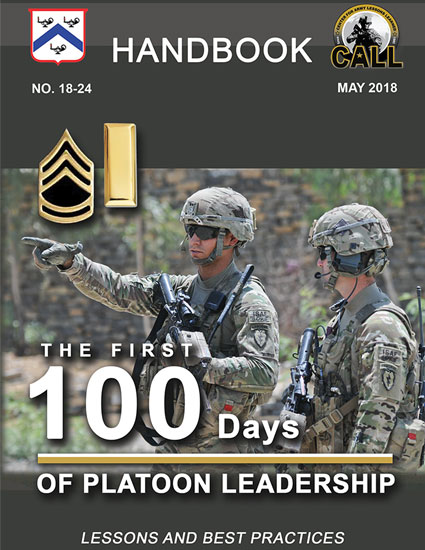 18-24: The First 100 Days of Platoon Leadership Handbook
18-24: The First 100 Days of Platoon Leadership Handbook
This volume for new platoon leaders and platoon sergeants contains insights on leadership, training management, Army systems, and more. Vignettes and lessons from current and former platoon-level leaders allow newly assigned leaders to learn from those who have gone before.
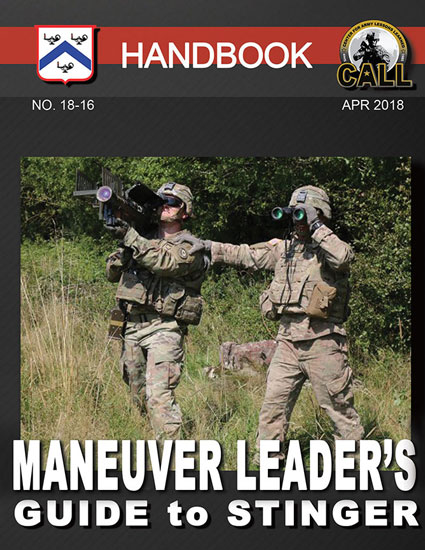 18-16: Maneuver Leader's Guide to Stinger
18-16: Maneuver Leader's Guide to Stinger
The Chief of Staff of the Army directed the Army to execute a plan to increase short-range air defense (SHORAD) capability. The immediate solution is to train and arm teams of Soldiers organic to select brigade combat teams with Stinger missiles. This directive is one line of effort as the force structure for a dedicated maneuver SHORAD capability increases. This handbook is meant to serve as a guide for the maneuver leader to help train and employ their Stinger teams.
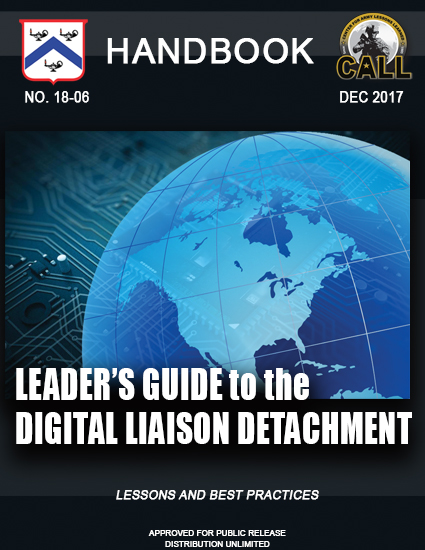 18-06 - Leader’s Guide to Digital Liaison Detachment handbook
18-06 - Leader’s Guide to Digital Liaison Detachment handbook
This handbook provides leaders and supporting staff in the operational Army with an overview of how to plan, train, and leverage the capabilities of digital liaison detachments (DLDs) that render a critical capability for mission command liaison and interoperability. Also included are operational insights from Center for Army Lessons Learned (CALL) assessment teams during exercises Anakonda 16 and Saber Guardian 17. DLDs are assigned or attached to selected theater armies and Army Service component commands. They are employed at theater armies or in support of corps and division echelons. These teams provide an Army Forces (ARFOR) commander with the capability to conduct liaison with subordinate or parallel joint and multinational headquarters within the operational area.
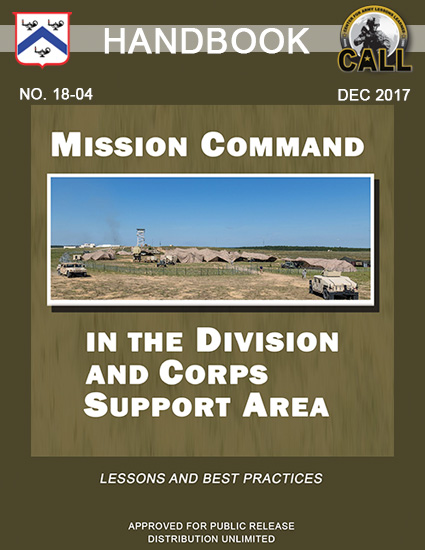 18-04 - Mission Command in the Division and Corps Support Area Handbook
18-04 - Mission Command in the Division and Corps Support Area Handbook
During warfighter exercises, it had become apparent that division and corps commanders were challenged with mission command of forces in their support areas. The commander of United States Army Forces Command directed commanders to establish a support area command post (SACP) to improve mission command. The Army’s new Field Manual (FM) 3-0, Operations (06 OCT 2017), incorporates this guidance by modifying the geographical organization of an area of operations. FM 3-0 scales down the size of the support area and adds a consolidation area. The consolidation area will be assigned to a maneuver brigade or division. This enables the maneuver enhancement brigade (MEB) to perform its traditional mission and focus efforts on operations in the support area. FM 3-0 formalizes the requirement for divisions and corps to establish a SACP (its doctrinal name, which is used throughout this handbook) to assist in controlling operations in the support and consolidation areas. This handbook provides divisions, corps, and their enablers several ways to implement recent guidance and doctrine for mission command in their support and consolidation areas. It provides the new doctrine that has been released in FM 3-0 as well as examples of how divisions and corps have employed their SACPs.
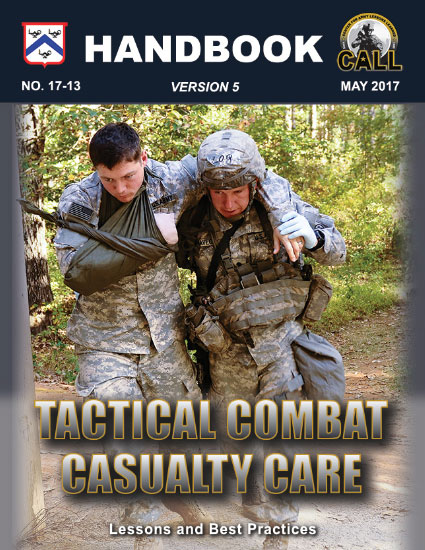 17-13: Tactical Combat Casualty Care Handbook, Version 5
17-13: Tactical Combat Casualty Care Handbook, Version 5
Tactical Combat Casualty Care Handbook updated to reflect current best practices for 2017
Pages
Newsletters
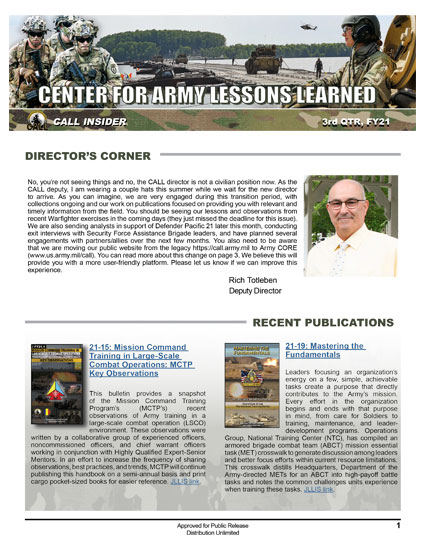 CALL Insider Newsletter 3rd QTR, FY21
CALL Insider Newsletter 3rd QTR, FY21
No, you’re not seeing things and no, the CALL director is not a civilian position now. As the
CALL deputy, I am wearing a couple hats this summer while we wait for the new director
to arrive. As you can imagine, we are very engaged during this transition period, with
collections ongoing and our work on publications focused on providing you with relevant and
timely information from the field.
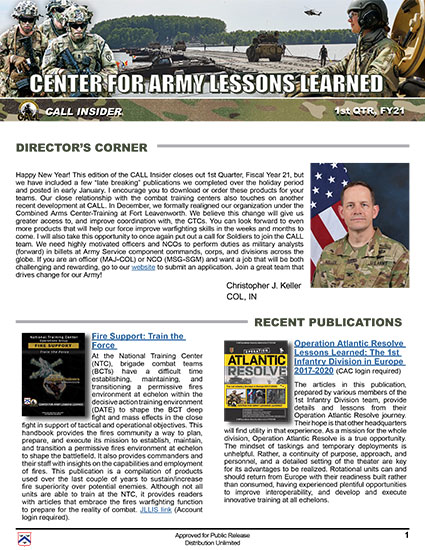 CALL Insider Newsletter, 1st QTR, FY21
CALL Insider Newsletter, 1st QTR, FY21
This edition of the CALL Insider features our roll-up of 1st quarter publications, reports, and articles. We continue to seek hard charging senior NCOs (MSG-SGM) and officers (MAJ-COL) to fill our military analyst (forward) positions at the Army Service component commands, corps, and divisions -- if you think you have what it takes, click on the provided link and submit an application! Finally, don’t miss the latest news and trends from the combat training centers!
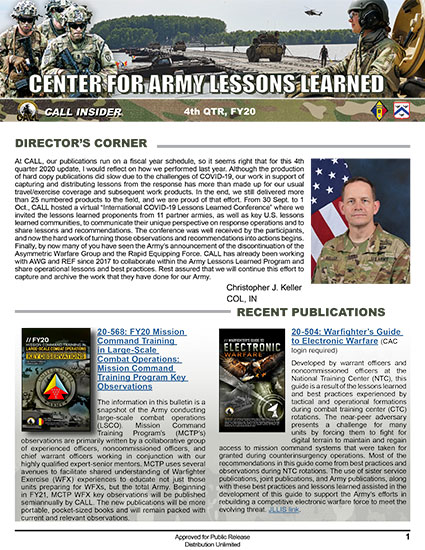 CALL Insider, 4th Qtr, FY20 Newsletter
CALL Insider, 4th Qtr, FY20 Newsletter
This edition of the CALL Insider features our roll-up of 4th quarter FY 20 publications, articles, studies, reports, and upcoming publications. Check out the flyer on page 5 for “Army 21: Brigade Combat Teams” – an interactive, multimedia learning tool designed to help Soldiers visualize and explore formations and organizations. Finally, don’t miss the latest news from the combat training centers!
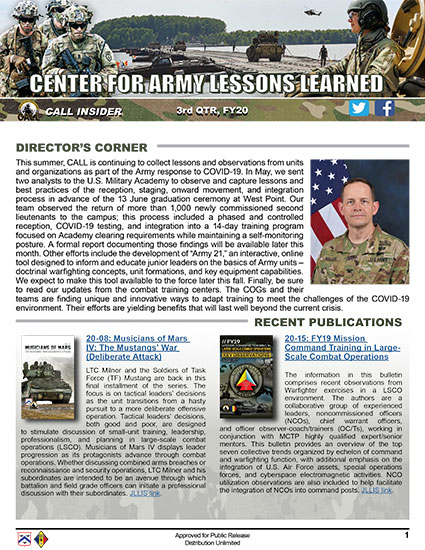 CALL Insider, 3rd Qtr, FY 20 Newsletter
CALL Insider, 3rd Qtr, FY 20 Newsletter
This edition of the CALL Insider includes a roll-up of 3rd quarter FY20
publications, reports, best practice submissions, and articles from the
field. The "News You Can Use" section features the latest audiobooks from
the Combined Arms Doctrine Directorate and resources from the Center for the
Army Profession and Leadership. Finally, check out ways the combat training
centers are adapting to the COVID-19 environment and how you can better
prepare yourself and your unit for the next CTC rotation.
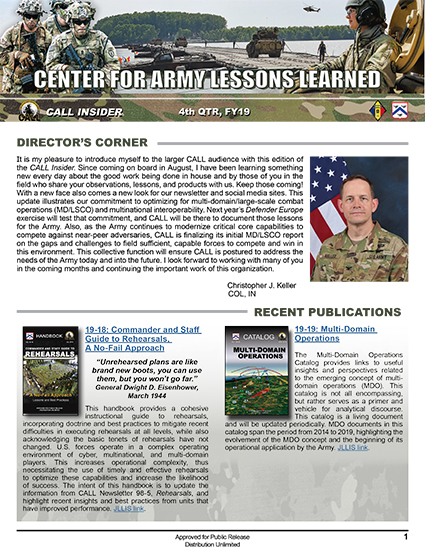 CALL Insider Newsletter 4th Quarter, FY2019
CALL Insider Newsletter 4th Quarter, FY2019
This update illustrates our commitment to optimizing for multi-domain/large-scale combat
operations (MD/LSCO) and multinational interoperability. Next year’s Defender Europe
exercise will test that commitment, and CALL will be there to document those lessons
for the Army. Also, as the Army continues to modernize critical core capabilities to
compete against near-peer adversaries, CALL is finalizing its initial MD/LSCO report
on the gaps and challenges to field sufficient, capable forces to compete and win in
this environment.
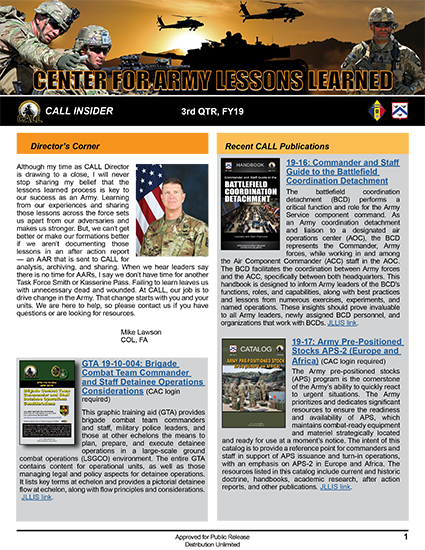 CALL Insider Newsletter 3rd Quarter, FY2019
CALL Insider Newsletter 3rd Quarter, FY2019
Key publications this quarter include the "Battlefield Coordination Detachment" handbook, several graphic training aids, and initial impressions from Yama Sakura. This edition also includes input from the Combat Training Centers and best practice and after action report submissions.
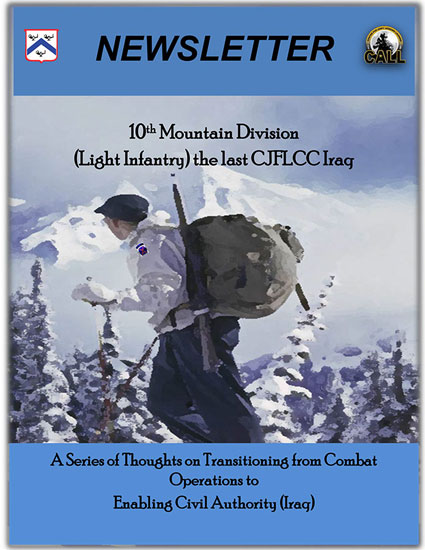 10th Mountain Division (Light Infantry) the last CJFLCC Iraq-- A Series of Thoughts on Transitioning from Combat Operations to Enabling Civil Authority (Iraq) Newsletter
10th Mountain Division (Light Infantry) the last CJFLCC Iraq-- A Series of Thoughts on Transitioning from Combat Operations to Enabling Civil Authority (Iraq) Newsletter
The 10th Mountain Division deployed its Headquarters to Iraq in February 2018 to assume the role of Combined Joint Forces Land Component Command. However, the Division deployed during a period of transition to a new Headquarters construct within the Combined Joint Task Force (CJTF), and found itself rapidly adjusting to a change of mission once on the ground. The Division staff was instrumental in shaping the new CJTF Headquarters and played key roles in understanding the operational environment and operationalizing the Reliable Partnership plan. The focus of the Division on working with the Iraqi Security Force (ISF) has been fundamental in its efforts to set the theater for Phase IV (stability) and Phase V (enable civil authority). This Newsletter focuses on the 10th Mountain Division’s experience dealing with the initial transition of the Army Headquarters and mission in Iraq.
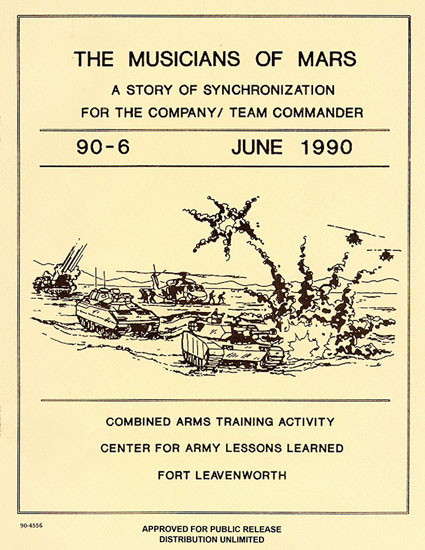 90-6 The Musicians of Mars: A Story of Synchronization For The Company/Team Commander - Newsletter
90-6 The Musicians of Mars: A Story of Synchronization For The Company/Team Commander - Newsletter
“The Musicians of Mars: A Story of Synchronization for the Company/Team Commander” is the first volume in the four-volume series of CALL publications. The books draw their name from a quote from MG George S. Patton in 1941. He describes commanders on the battlefield as akin to conductors of fine orchestras: “There is still a tendency in each separate unit ... To be a one-handed puncher. By that I mean the rifleman wants to shoot, the tanker to charge, the artilleryman to fire ... That is not the way to win battles. If the band played a piece first with the piccolo, then with the brass horn, then with the clarinet, and then with the trumpet there would be a hell of a lot of noise but no music. To get harmony in music each instrument must support the others. To get harmony in battle, each weapon must support the other. Team play wins. You musicians of Mars ... Must come into the concert at the proper place and at the proper time.”
This volume tells a story of synchronization from the maneuver team commander's perspective. It is not intended to be the perfect solution, rather a story showing the critical tasks that most commonly cause units to not meet their training objectives. The characters and the battles are fictional, the story is not. The successes and failures are found everyday as units around the world train for their concert with Mars. Our intent is for the reader to finish with a better understanding of synchronization and how better to prepare themselves and their soldiers to become "Musicians of Mars."
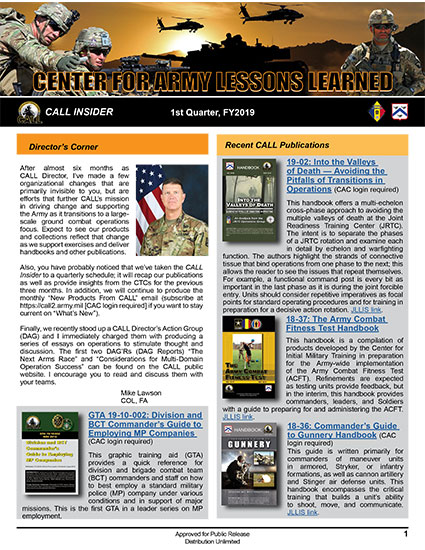 CALL Insider Newsletter 1st Quarter, FY2019
CALL Insider Newsletter 1st Quarter, FY2019
After almost six months as CALL Director, I've made a few organizational changes that are primarily invisible to you, but are efforts that further CALL’s mission in driving change and supporting the Army as it transitions to a large-scale ground combat operations focus. Expect to see our products and collections reflect that change as we support exercises and deliver handbooks and other publications.
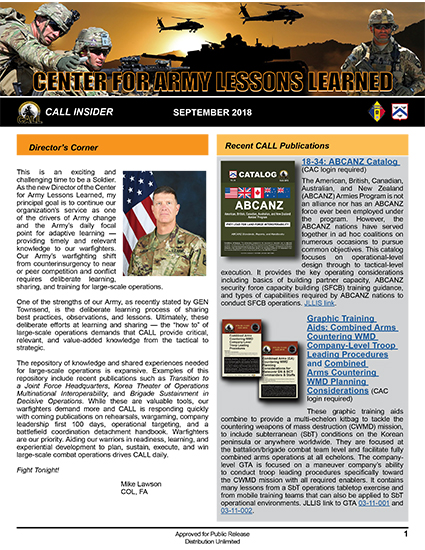 CALL Insider Newsletter September 2018
CALL Insider Newsletter September 2018
This is an exciting and challenging time to be a Soldier. As the new Director of the Center for Army Lessons Learned, my principal goal is to continue our organization?s service as one of the drivers of Army change and the Army?s daily focal point for adaptive learning ? providing timely and relevant knowledge to our warfighters. Our Army?s warfighting shift from counterinsurgency to near or peer competition and conflict requires deliberate learning, sharing, and training for large-scale operations.
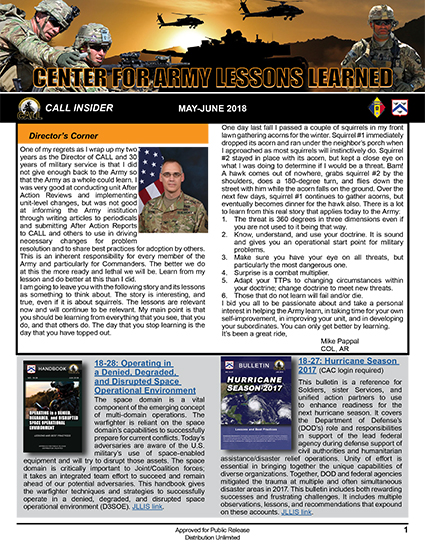 CALL Insider Newsletter MAY-JUN 2018
CALL Insider Newsletter MAY-JUN 2018
One of my regrets as I wrap up my two years as the Director of CALL and 30 years of military service is that I did not give enough back to the Army so that the Army as a whole could learn. I was very good at conducting unit After Action Reviews and implementing unit-level changes, but was not good at informing the Army institution through writing articles to periodicals and submitting After Action Reports to CALL and others to use in driving necessary changes for problem resolution and to share best practices for adoption by others. This is an inherent responsibility for every member of the Army and particularly for Commanders. The better we do at this the more ready and lethal we will be. Learn from my lesson and do better at this than I did.
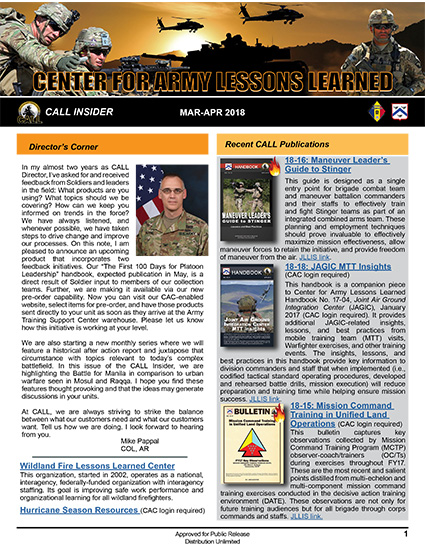 CALL Insider Newsletter Mar-Apr 2018
CALL Insider Newsletter Mar-Apr 2018
In my almost two years as CALL
Director, I’ve asked for and received
feedback from Soldiers and leaders
in the field: What products are you
using? What topics should we be
covering? How can we keep you
informed on trends in the force?
We have always listened, and
whenever possible, we have taken
steps to drive change and improve
our processes. On this note, I am
pleased to announce an upcoming
product that incorporates two
feedback initiatives. Our “The First 100 Days for Platoon
Leadership” handbook, expected publication in May, is a
direct result of Soldier input to members of our collection
teams. Further, we are making it available via our new
pre-order capability. Now you can visit our CAC-enabled
website, select items for pre-order, and have those products
sent directly to your unit as soon as they arrive at the Army
Training Support Center warehouse. Please let us know
how this initiative is working at your level.
Pages
News from the Front
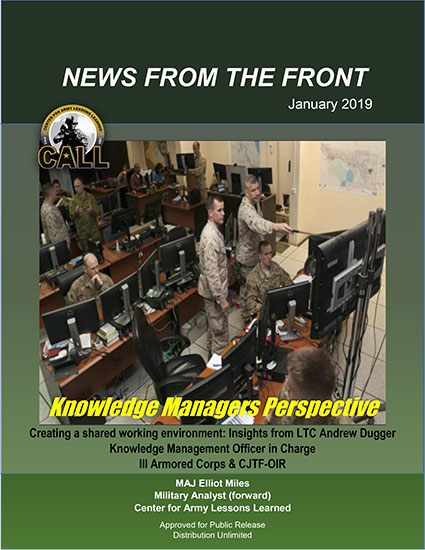 NFTF - Knowledge Managers Perspective
NFTF - Knowledge Managers Perspective
This NFTF is a transcription of the KLI covering various topics ranging from capability gaps requiring leaders to rethink training and skills among KM soldiers, programming or coding skills (not typically found in the U.S. Army training curriculums) and Scrum Master certification.
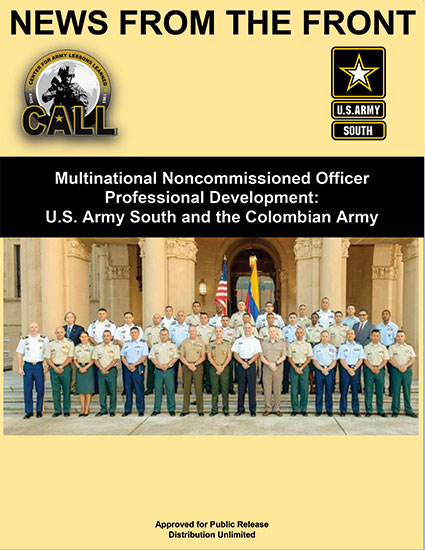 NFTF - Multinational Noncommissioned Officer Professional Development: U.S. Army South and the Colombian Army
NFTF - Multinational Noncommissioned Officer Professional Development: U.S. Army South and the Colombian Army
The Programa Integral Para Suboficiales de Alta Jerarquia (PISAJ) program is a semi-annual event as recorded in U.S. Army South-Colombian Army (COLAR) bilateral staff talks agreed-to-actions through 2023. Specifically, it is a military-to-military engagement with the Colombian Military Joint Sergeants Major Academy. Based on a several desired outcomes for this 12th iteration of PISAJ, U.S. Army South orchestrated and facilitated specialized training to build on senior NCO leader competencies and increase the medical capabilities and knowledge of the COLAR sergeants major. The focus was to educate Colombian joint force senior NCOs on best practices for developing a core curriculum for their future sergeants major academy, support to transformation initiatives, and synchronizing efforts to meet the U.S. Southern Command Theater Campaign Plan.
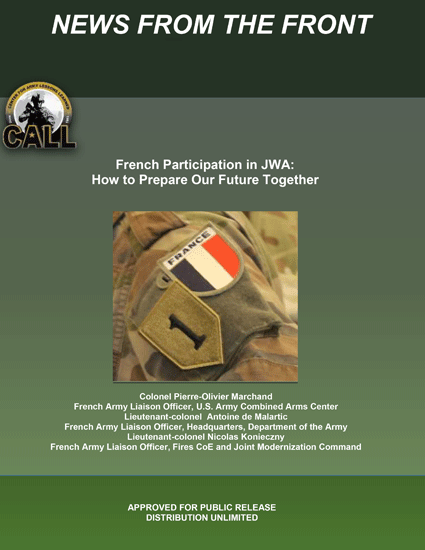 NFTF - French Participation in JWA How to Prepare Our Future Together
NFTF - French Participation in JWA How to Prepare Our Future Together
This article discusses the French Army’s participation since 2018 in the Joint Warfighting Assessment (JWA) series. As part of the strategic bilateral objectives with the U.S. Army’s Strategic Vision Statement, the French Army’s vision is to conduct a lasting and long-term commitment to JWA, because it considers this exercise a key event for improving interoperability at the brigade level, as well as a means for testing new concepts. The author provides the lessons learned from JWA 19 and how this will prepare them for 2020.
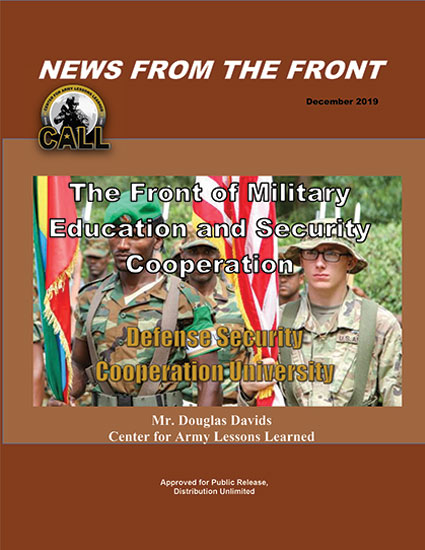 NFTF - The Front of Military Education and Security Cooperation
NFTF - The Front of Military Education and Security Cooperation
Security cooperation is a multifaceted effort that requires more than just planning to develop the skills of a foreign security force. In 2017, the National Defense Authorization Act created the DOD Security Cooperation Workforce Development Program (SCWDP) to develop and manage supporting security programs, improve the quality of the security cooperation workforce, and ensure personnel have the appropriate level of expertise and experience to perform their missions. The 2017 NDAA also directed the Defense Security Cooperation Agency (DSCA) to manage the SCWDP’s training and education standards, as well as identify and define training and certification requirements. Specifically, DSCA was required to “establish and maintain a school to train, educate, and certify the security cooperation workforce … .” To meet this obligation, DSCA established the Defense Security Cooperation University (DSCU) in September 2019, to educate and certify 20,000 U.S. government employees’ security cooperation and standardize their training. This article provides a brief description of the threat environment security cooperation must work within, an overview of the new DSCU, a discussion of the legal requirements emplaced on the DSCU, and an example course from DSCU.
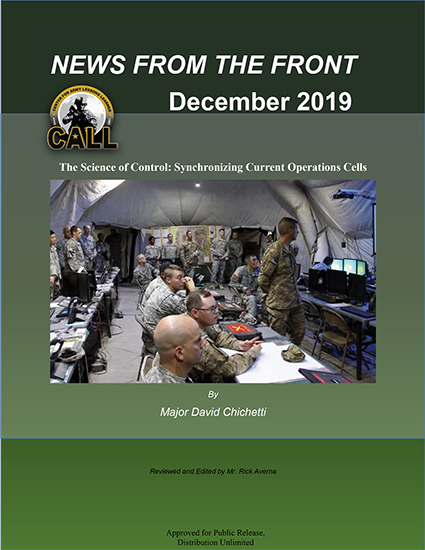 NFTF - The Science of Control: Synchronizing Current Operations Cells
NFTF - The Science of Control: Synchronizing Current Operations Cells
The current operations (CUOPS) cell is essential to translating plans to orders and eventually to the execution of combat operations. The CUOPS integrating cell is critical in synchronizing operations, sustaining the common operational picture and mitigating risk to the mission. In the operations process, the CUOPS cell is the commander's most prominent tool to understand, describe, visualize, and direct operations. This article discusses the processes and techniques that optimize CUOPS cells’ control over forces. In addition to command and control systems, this article intertwines techniques to manage CUOPS personnel and enhance the rapid decision-making and synchronization process. The operations process of planning, preparing, executing, and assessing forms the outline of this article. The intent is to bridge doctrinal understanding with the practical application of managing a CUOPS cell.
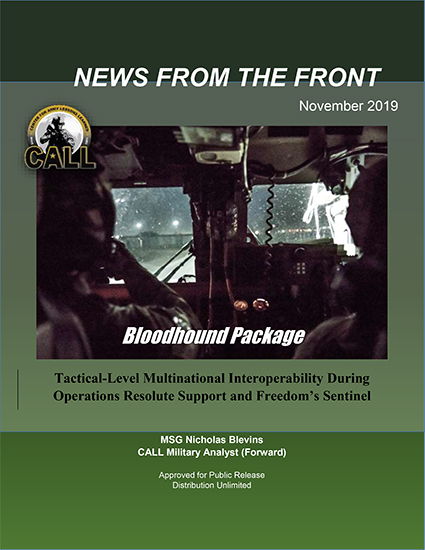 NFTF - Tactical-Level Multinational Interoperability During Operations Resolute Support and Freedom's Sentinel
NFTF - Tactical-Level Multinational Interoperability During Operations Resolute Support and Freedom's Sentinel
A Center for Army Lessons Learned (CALL) military analyst (forward) embedded with the 264th Engineer Clearance Company (Spartans) and developed observations base on their operations in support of Operations Resolute Support and Freedom's Sentinel. The Spartans provided CALL with these insights while conducting combat patrols on area denial and route clearance, as well as experiencing a look at a "Bloodhound" package.
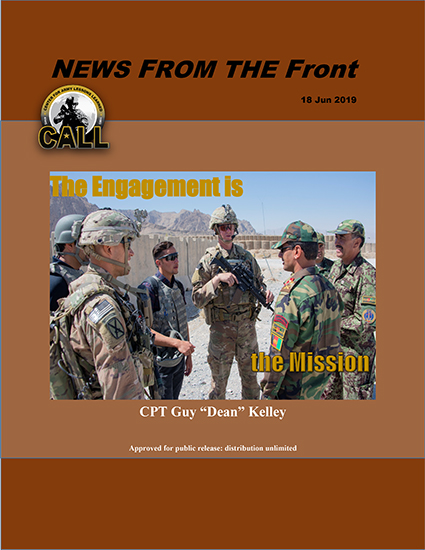 NFTF - The Engagement is the Mission
NFTF - The Engagement is the Mission
Soldiers that will serve as combat advisors have to recognize that the engagement is the mission and choose to make that paradigm shift. Five areas for combat advisors to focus their energy during and frame their understanding of combat advising are clearly understanding the objectives, wargaming, interpreter preparation, understanding what the questions of the key leader mean, and understanding the importance of the recorder. The application of these baseline combat advising concepts will result in combat advising success.
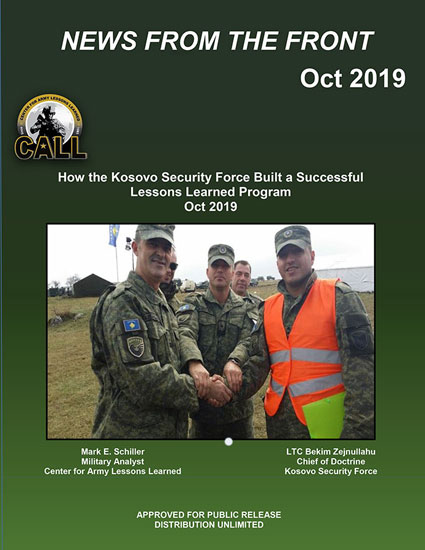 NFTF: How the Kosovo Security Force Built a Successful Lessons Learned Program
NFTF: How the Kosovo Security Force Built a Successful Lessons Learned Program
The Kosovo Security Force (KSF) has an exemplary lessons learned program that continuously contributes to improving its training and operational performance. The KSF’s successful lessons learned program did not happen overnight, but developed over a period of almost five years with continual senior leadership support, outside assistance from the United States Army’s Center for Army Lessons Learned (CALL), and its own internal, progressive improvements to its program.
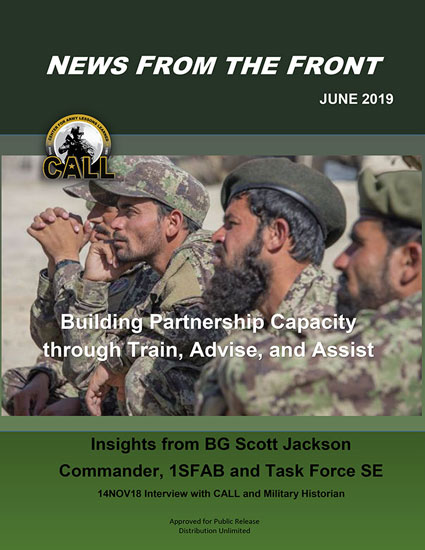 NFTF: Building Partnership Capacity through Train, Advise, and Assist - Insights from BG Jackson, Commander, 1SFAB
NFTF: Building Partnership Capacity through Train, Advise, and Assist - Insights from BG Jackson, Commander, 1SFAB
The 1st Security Force Assistance Brigade, led by BG Scott Jackson, supported the NATO Resolution Support mission and Operation Freedom’s Sentinel from February to November 2018 as the Army's first unit dedicated to training, advising, assisting, accompanying, and enabling conventional foreign security force partners. This article outlines the observations of BG Jackson and highlights areas including predeployment, measuring training success, continuity, and use of what he calls the “Afghan blanket.”
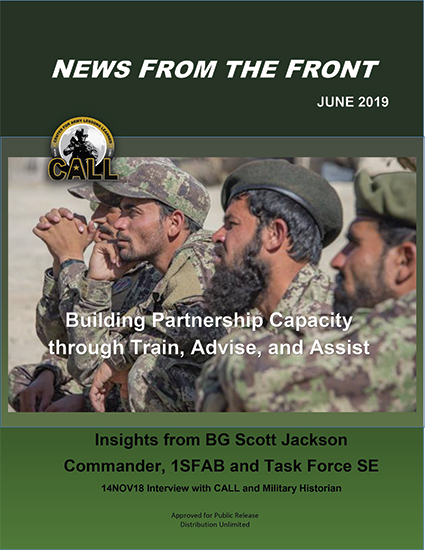 NFTF - Building Partnership Capacity through Train, Advise, and Assist - Insights from BG Jackson, Commander, 1SFAB
NFTF - Building Partnership Capacity through Train, Advise, and Assist - Insights from BG Jackson, Commander, 1SFAB
The 1SFAB supported RSM and OFS with the Army’s first unit dedicated to training, advising, assisting, accompanying and enabling (A3E) conventional foreign security force partners from February to November 2018. The 1SFAB had a positive impact on NATO and U.S. strategic initiatives in Afghanistan by advising Afghan National Defense and Security Forces (ANDSF) at tactical levels of command that had not been consistently and directly advised since 2015. 1SFAB regularly advised kandaks, brigades, corps headquarters, regional military training centers, and the Capital Division responsible for securing Kabul.
1SFAB’s six battalions advised Afghan partners in every Afghan National Army (ANA) corps and each of RSM’s regional Train, Advise and Assist Commands (TAACs). The brigade also advised Afghan National Police (ANP) and Afghan Special Security Forces (ASSF) units.
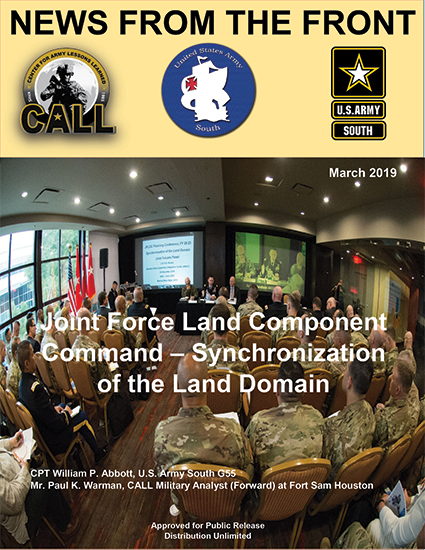 NFTF - Joint Force Land Component Command - Synchronization of the Land Domain
NFTF - Joint Force Land Component Command - Synchronization of the Land Domain
In November 2018, United States Army South hosted the second annual Joint Force Land Component Command Planning Conference at Joint Base San Antonio/Fort Sam Houston. This year's theme was "Synchronization of the Land Domain." The event brought together key land domain stakeholders across the United States Southern Command area of responsibility. The focus of the event was to plan and collaborate on complex mission sets, prioritize resources, establish timelines, and set the conditions for current and future operations.
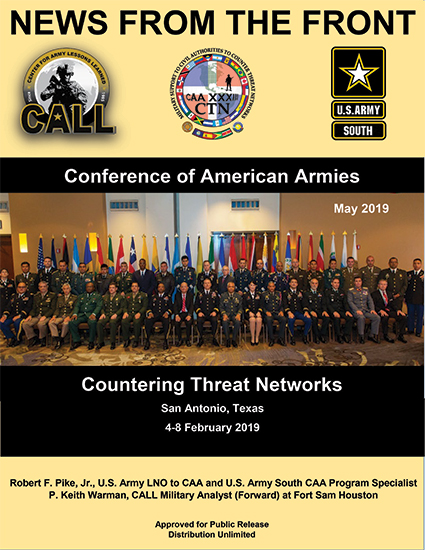 NFTF - Conference of American Armies - Countering Threat Networks
NFTF - Conference of American Armies - Countering Threat Networks
The Conference of American Armies (CAA) is a military organization made up and led by armies from the American continents with the authorization of their respective countries. The CAA conducts a two-year cycle of specialized conferences and exercises hosted by different member armies. During this XXXIII Cycle of the CAA, 2018-2019, the U.S. Army conducted the specialized conference on Military Support to Countering Threat Networks (CTN) at San Antonio, TX, from 4-8 February 2019.
Pages
Other Products
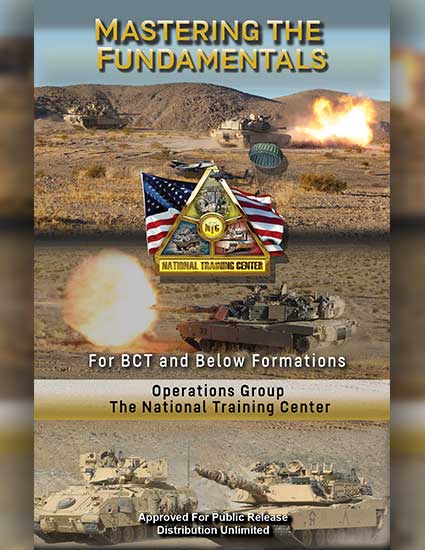 21-19 - Mastering the Fundamentals
21-19 - Mastering the Fundamentals
Regardless of echelon, the Army needs units to be masters in a handful of fundamental tasks. By focusing an organization’s energy on a few, simple, achievable tasks, leaders create a purpose that directly contributes to the Army’s mission. Every effort in the organization begins and ends with that purpose in mind, from care for Soldiers to training, maintenance, and leader-development programs. Operations Group, National Training Center, has compiled an armored brigade combat team (ABCT) mission essential task (MET) crosswalk to generate discussion among leaders and better focus efforts within current resource limitations. This crosswalk distills Headquarters, Department of the Army-directed METs for an ABCT into high-payoff battle tasks and notes the common challenges units experience when training these tasks.
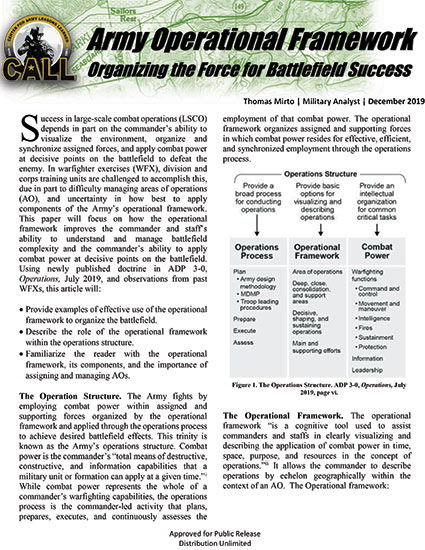 Army Operational Framework: Organizing the Force for Battlefield Success
Army Operational Framework: Organizing the Force for Battlefield Success
This paper describes the Army’s Operational Framework and how its proper use and understanding can improve the commander and staff’s ability to organize assigned forces and apply combat power at decisive points on the battlefield. Using newly published doctrine in Army Doctrine Publication 3-0, Operations, and observations from Warfighter Exercises, this article will:
1) Provide examples of effective use of the operational framework to organize the battlefield.
2) Describe the role of the operational framework within the operations structure.
3) Familiarize the reader with the operational framework, its components, and the importance of assigning and managing subordinate unit areas of operations.
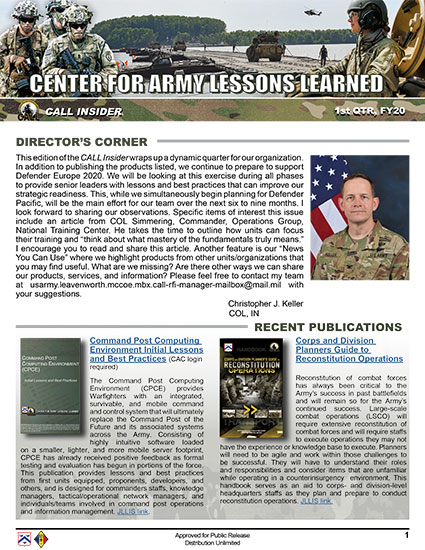 CALL Insider 1st QTR, FY 2020
CALL Insider 1st QTR, FY 2020
Latest publications, articles, best practices, and graphic training aids from CALL. This edition also features an article from the National Training Center Commander, Operations Group, entitled "Focusing on the Fundamentals."
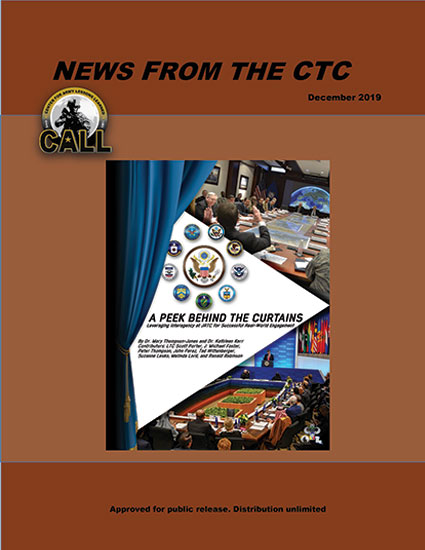 NFTCTC - A Peek Behind the Curtain: Leveraging Interagency at JRTC for Real-World Engagement
NFTCTC - A Peek Behind the Curtain: Leveraging Interagency at JRTC for Real-World Engagement
The purpose of this article is to facilitate effective engagement between unified action partners (UAPs) and the centerpiece of the Army's formation, the brigade combat team (BCT). It provides valuable insights from interagency (IA) and international organization experts who have supported dozens of training rotations at the Joint Readiness Training Center. The goal is to help BCT leaders and units better navigate and leverage UAP, particularly IA, in the operational environment.
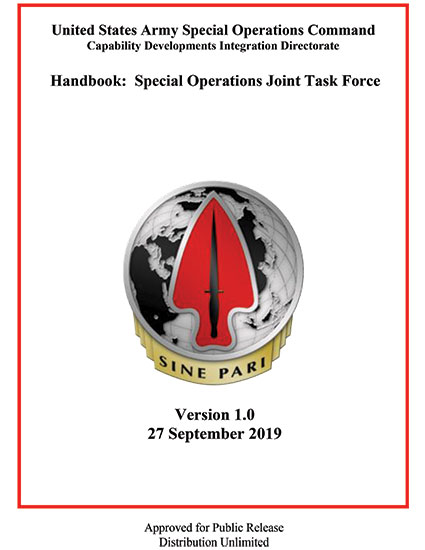 Special Operations Joint Task Force Handbook
Special Operations Joint Task Force Handbook
This handbook consists of two parts for use by two distinct audiences. Section one, the SOJTF Employment Guide is an ?up and out? strategic communication for use by senior leaders and staff members who will find it useful when incorporating a SOJTF into campaign plans and contingency operations that involve large scale combat. Section two is a ?down and in? document aimed at SOJTF commanders and their staffs who can use the information as a checklist for developing SOJTF plans and policies when supporting the Joint Force in large scale combat at the operational level of war.
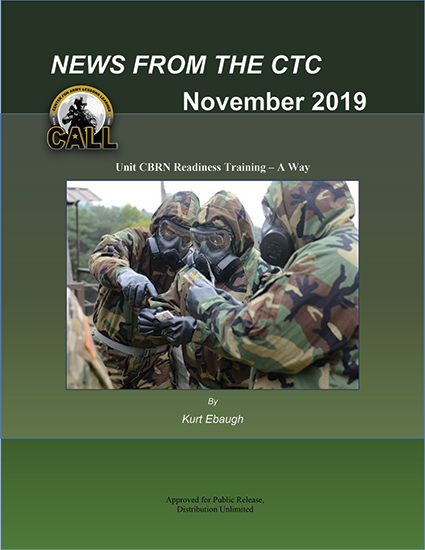 NFTCTC - Unit CBRN Readiness Training - A Way
NFTCTC - Unit CBRN Readiness Training - A Way
There appears to be a dilemma on how to manage finite training opportunities and best conduct small-unit level chemical, biological, radiological, and nuclear (CBRN) tasks during home-station training to ensure units are effectively trained in mission oriented protective posture gear exchange, selective unmasking, and decontamination. Much of what will be asked of a Soldier against a near-peer threat in a contaminated battlefield will require fighting "dirty" for extended periods of time. Maneuver formations at the brigade level and lower will need to conduct hasty decontamination as far forward as possible in order to continue to sustain operational tempo. Mission success requires proficiency in these basic CBRN skills. This article is designed to describe a training approach that will generate the necessary basic CRBN individual and collective skills proficiency.
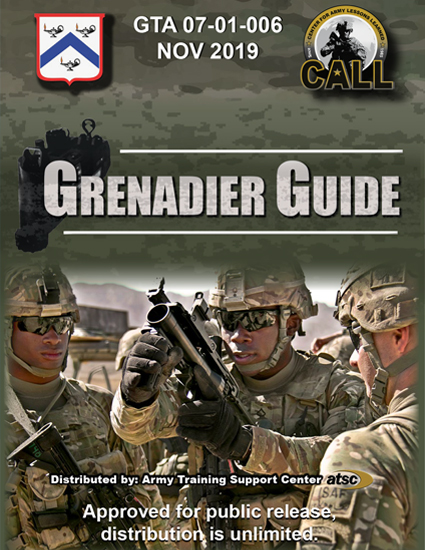 GTA 07-01-006 - Grenadier Guide
GTA 07-01-006 - Grenadier Guide
This graphic training aid (GTA) provides technical information about combat techniques for the M320 grenade. Which gives designated grenadiers basic information to successfully integrate the M320 into their combat operations. Refer to Training Manual (TM) 3-22.31.
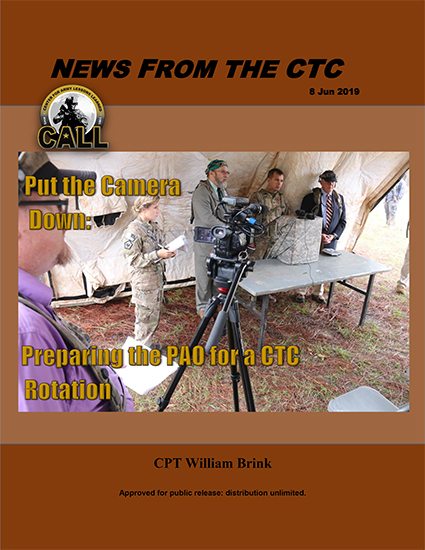 NFTCTC - Put the Camera Down: Preparing the Public Affairs Officer for a JRTC Rotation
NFTCTC - Put the Camera Down: Preparing the Public Affairs Officer for a JRTC Rotation
This article is intended for all units conducting home station training to prepare themselves for a combat training center (CTC) rotation. The author discusses a recurring trend at the Joint Readiness Training Center (JRTC) and the challenges that the Public Affairs Officer (PAO) face. Fig 1. Shows the results of misplaced PAO home station training. A Soldier during a recent JRTC rotation covers the camera lens of a credentialed, American Media on the Battlefield (MoB) Role-player. Public affairs officers and sections at the Brigade Combat Team (BCT) level are struggling with media interaction training due to its removal from AR 350-1 training requirements, reduced section size, and command emphasis on command information content acquisition instead of communication planning and training.
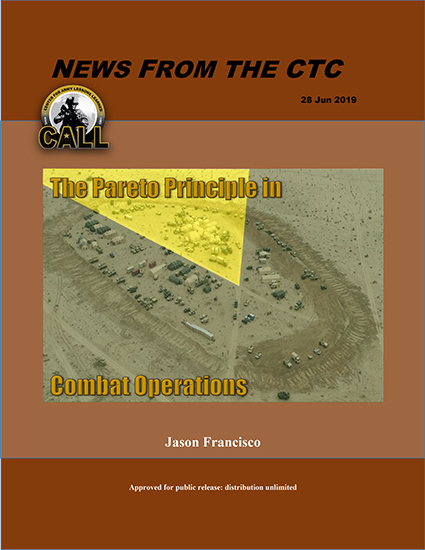 NFTCTC - The Pareto Principle in Combat Operations
NFTCTC - The Pareto Principle in Combat Operations
The Pareto principle simply stated is that 80% of the desired results are derived from 20% of the input (also known as the 80/20 rule in which roughly 80% of the effects come from 20% of the causes). This principle has been proven in business and finance, in addition to military implications. This article focuses on key components that produce the greatest impact across the brigade combat team (BCT). The Army's focus on decisive action is suffering from a decade of counterinsurgency operations, necessitating a much more rapid evolution in preparing for a near-peer threat across multiple domains. Inability to adapt the military's current training to fit the current threat increases the probability of a deadly learning curve in the next war or conflict. According to the Pareto principle, marked improvement is achieved through increasing focus on the best 20% of processes related to combat training; specifically, reconnaissance, command and control nodes, the common operational picture, and sustainment. Each of these focal points tie in and support each other in a highly complex battlefield.
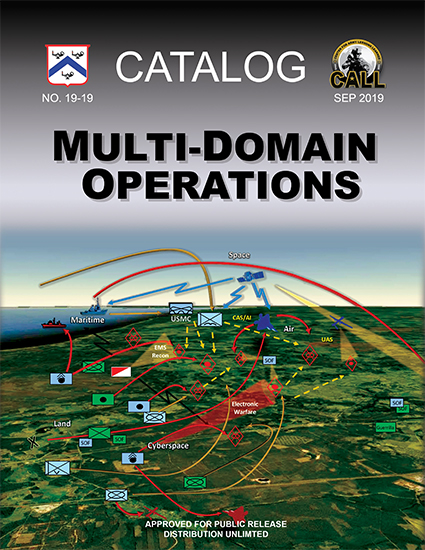 19-19 - Multi-Domain Operations Catalog
19-19 - Multi-Domain Operations Catalog
The Multi-Domain Operations Catalog provides links to useful products with insights and perspectives related to the emerging concept of multi-domain operations (MDO). This catalog is not all encompassing, but rather serves as a primer and vehicle to promote analytical discourse. This catalog is a "living" document and is intended to be updated periodically. MDO documents in this catalog span the period from 2014 to 2019, highlighting the evolution of the MDO concept and the beginning of its operational application by the Army.
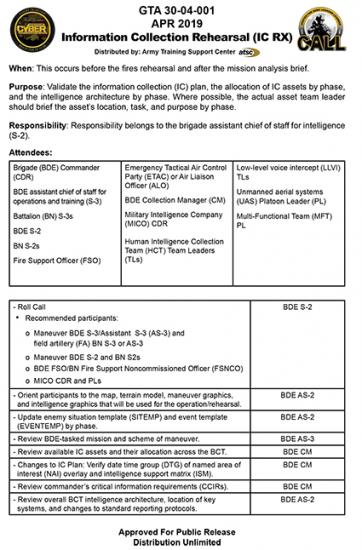 GTA 30-04-001- Information Collection Rehearsal (IC RX)
GTA 30-04-001- Information Collection Rehearsal (IC RX)
This GTA provides information on when to conduct the information collection rehearsal and how to validate the information collection (IC) plan, the allocation of IC assets by phase, and the intelligence architecture by phase.
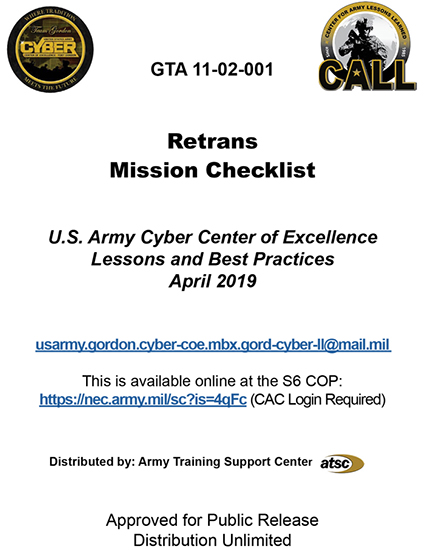 GTA 11-02-001 Retrans Mission Checklist
GTA 11-02-001 Retrans Mission Checklist
This GTA provides the reader with a checklist in order to accomplish a retransmission mission.

